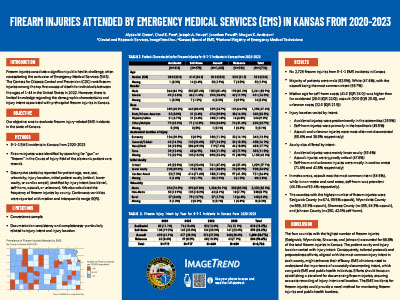ABSTRACTS
Firearm Injuries Attended by Emergency Medical Services (EMS) in Kansas from 2020–2023Author: Alyssa Green, Chad E. Pore, Joseph A. House, Jonathan R. Powell, and Morgan K. Anderson | | Associate Authors:
Introduction: Firearm injuries are a major public health concern in the United States, with the Centers for Disease Control and Prevention ranking them among the top five causes of death for individuals aged 1 to 44 years in 2022. Emergency medical services (EMS) play a crucial role in responding to firearm injuries, but there is limited information on the demographics and injury intent associated with prehospital firearm injuries in Kansas. Objective: To evaluate firearm injury-related EMS incidents in Kansas. Methods: A retrospective analysis was conducted on 9-1-1 EMS incidents in Kansas from 2020–2023. Firearm injuries were identified by searching for “gun” or “firearm” in the Cause of Injury field of electronic patient care records. Descriptive statistics were reported for patient age, race, sex, urbanicity, injury location, and initial patient acuity (critical, lower acuity, cardiac arrest), stratified by injury intent (accidental, self-harm, assault, unknown). Continuous variables were reported with median and interquartile range (IQR). Results: A total of 2726 firearm injuries were identified, with the majority of patients being male (82.9%), White (47.6%), and with assault being the most common intent (58.7%). The median age in years for self-harm cases (41.0 [IQR = 34.0]) was higher than for accidental (28.0 [IQR = 22.0]), assault (30.0 [IQR = 20.0]), and unknown cases (32.0 [IQR = 21.5]). Injury location varied by intent, with accidental injuries predominantly in the extremities (39.5%) and self-harm injuries primarily in the head/neck (49.5%). Injury location was often not documented for assault (55.6%) and unknown (38.9%). Acuity varied by intent; accidental injuries were mostly lower acuity (69.4%) and assault was typically critical (47.6%). Cardiac arrest was most often seen in injuries from self-harm (71.6%) and unknown (41.5%). In metro areas, assault was the most common intent (64.6%); self-harm was prevalent in nonmetro (44.1%) and rural (53.4%) areas. Conclusion: Patient acuity and injury location varied with firearm injury intent. The findings of this study highlight the importance of accurately documenting injury intent and location, which can guide EMS and public health initiatives. Efforts should focus on establishing a standard for documenting firearm injuries, ensuring accurate recording of injury intent and location. Tailored protocols and preparedness efforts, aligned with the most common injury intent in area, might enhance their efficacy. EMS data could provide a novel method for monitoring the public health burden of firearm injuries.
|

